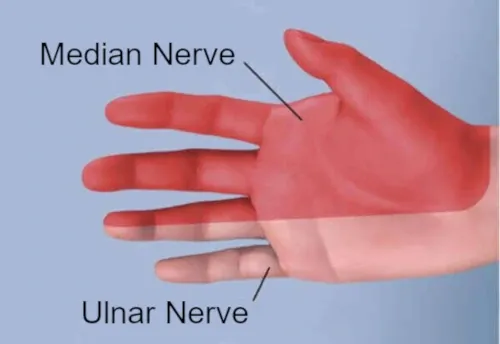Do You Have Carpal Tunnel or Fibromyalgia?
From Dr. Z - Carpal tunnel syndrome specialist
Do You Have Carpal Tunnel or Fibromyalgia?
Patients frequently wonder if they're suffering from carpal tunnel or fibromyalgia. Symptoms are similar. So similar, in fact, that at first glance it might be difficult for a doctor to tell the difference.
- Think you have carpal tunnel? Complimentary self-test
- Already know you have carpal tunnel?
This Quiz tells you its severity
It's bad enough that symptoms of fibromyalgia and carpal tunnel syndrome can overlap. But to complicate matters further, diagnosing fibromyalgia is not a simple process. No single exam is enough. Even blood tests are inadequate. Blood tests are usually used to rule out other conditions, like rheumatoid arthritis.
It's said that fibromyalgia is a "diagnosis by exclusion". In other words, doctors have to exclude everything else to conclude you have it. Therefore, an array of blood tests are used rule out other, more obvious disorders. And even then, a diagnosis of fibromyalgia can still be inconclusive. Truly, it's a very mysterious condition that evades simple diagnosis.
In contrast, determining if your problem is due to carpal tunnel syndrome is much easier. Often, simple tests you can do on yourself (called provocative tests) can accurately determine if you have this neurological disorder.
It’s also very important for doctors and patients to understand that you can have both conditions at the same time.
- Patients with fibromyalgia often have carpal tunnel syndrome as well.
- But fewer patients with carpal tunnel syndrome also have fibromyalgia.
Therefore, determining if you have carpal tunnel or fibromyalgia (or both) starts by diagnosing carpal tunnel syndrome. This is relatively easy. If you're negative for carpal tunnel, then blood tests can eliminate other disorders.
Generally speaking, the main overlapping symptoms between the two conditions are hand or wrist pain, and numbness or tingling. But carpal tunnel has more consistent signs that can be easily tested and verified.
Symptoms of fibromyalgia
In stark contrast to carpal tunnel syndrome, fibromyalgia is associated with an array of other signs and symptoms. And fibromyalgia symptoms vary greatly from person to person. For instance, some people have only a few or minor symptoms. But others can have several or more intense symptoms.
The intensity of fibromyalgia symptoms also varies widely. Depending on the person, they can range from merely annoying to totally incapacitating.
Hallmark characteristics of fibromyalgia
- About 75-90% of people who have fibromyalgia are
women. Scientists are not sure why this is so.
- People with fibromyalgia usually have pain all over their body. And they usually feel very tired most of the time. These symptoms force patents to limit their normal physical activities.
- Generally, fibromyalgia sufferers have difficulty concentrating and remembering.
- Many sufferers have symptoms so debilitating that they must quit or change jobs.
Hallmark symptoms of fibromyalgia
- Pain (and tender points)
- General fatigue
- Sleeping problems
- Memory and concentration problems (called fibro fog)
- Depression or anxiety
- Morning stiffness
- Numbness and tingling (pins & needles) in hands, arms, feet and legs
- Headaches
- Irritable bowel syndrome
- Urinary problems
- Painful menstrual cramping
Unfortunately, there are no individual lab tests to confirm fibromyalgia. But a promising blood test that uses vibrational spectroscopy seems promising as a new diagnostic tool. Unfortunately, it's years away from widespread use.
Problems with a fibromyalgia diagnosis
Since diagnosing fibromyalgia is a "diagnosis by exclusion", your doctor will rule out other conditions like rheumatoid arthritis, polymyalgia rheumatica, lupus, and hypothyroidism.
Each of these disorders can also cause the symptoms. Therefore, examining your blood chemistry can rule out those other candidate disorders. However, new research is challenging the notion of diagnosis by exclusion.
Currently, blood tests excluding these other conditions is key to pinpointing were the problem is coming from. Oftentimes the blood tests come up negative for other suspected conditions.
Finally, a thorough diagnosis of fibromyalgia often takes months to conclude. For one thing, that's because your doctor must exclude everything else, mostly by using an array of blood tests. But another factor delaying a proper diagnosis is that sufferers are often misunderstood.
For example, fibromyalgia sufferers frequently are considered complainers or malingerers. In fact, friends, family, colleagues, and even medical providers may believe the person is not really sick, but merely exaggerating symptoms. This is emotionally frustrating and draining. And it's why fibromyalgia sufferers may exhibit deep psychological injury in addition to the already incapacitating physical symptoms.
As an aside, a new study has demonstrated that pain from fibromyalgia can get significantly worse because of how the patient thinks. The study shows that when there is a perceived loss of control over the pain, the pain actually feels more intense. This just adds more to the mystery of the disorder, and the complexity of being diagnosed with fibromyalgia.

Symptoms of carpal tunnel syndrome
In contrast to fibromyalgia, carpal tunnel symptoms are much easier to identify. That's because the symptoms follow a general pattern, making testing relatively simple. For the most part, the physical exam is the best way a doctor can determine if you have carpal tunnel or fibromyalgia.
Hallmark characteristics of carpal tunnel syndrome
- Like fibromyalgia, carpal tunnel syndrome occurs more often in women. In fact, it's so prevalent in women that carpal tunnel is largely considered a women’s issue.
- The main characteristic of carpal tunnel syndrome is pain, numbness, tingling, burning, cramping, and shooting electric shocks in the fingers and hand.
- Usually one or more symptoms will wake you up at night.
- Symptoms usually occur when your hand is resting.
- The little finger is never involved.
Hallmark symptoms of carpal tunnel syndrome
Symptoms occur in the hand (palm), fingers, and wrist. They include any one or more of the following:
- Deep, hurting pain in the fingers, especially the thumb and pointer finger.
- Sometimes pain radiates or shoots up the arm toward the elbow, like electric shocks.
- Numbness or tingling (pins & needles) in the fingertips.
- Shooting electric shocks, especially when grasping objects.
- Burning or itching sensation on the palm.
- Hand weakness and loss of grip strength.
- Loss of dexterity in the hand and finger (resulting in clumsiness).
- Feeling of puffiness even though the hand or fingers look normal.
Usually, the thumb and first (pointer) finger have more severe symptoms. Carpal tunnel syndrome is also considered a bilateral condition. That means in 80% of people who have this condition, symptoms also begin on the other hand within 6 months.
A
doctor can perform 3 key
carpal tunnel provocative tests to show if you have this condition. These are the Tinel, Phalen and Durkan tests. They are highly reliable and (when performed properly) are actually better than
electrodiagnostic tests like the EMG.

Carpal tunnel or fibromyalgia - or both?
About 5% of the US population has carpal tunnel syndrome at this very moment. Likewise, about 2% of the US population has fibromyalgia. Therefore, there’s a reasonable chance a person can have either carpal tunnel or fibromyalgia - or even both conditions at the same time.
Whether or not the two conditions are related is debated. And as mentioned above, people with fibromyalgia often have carpal tunnel syndrome as well. But far fewer patients who have carpal tunnel also have fibromyalgia.
Doctors are usually aware that a patient’s pain symptoms may not be a “one or the other” diagnosis. This is crucial because determining what's causing the symptoms is the only effective way to treat the problem. So the importance of diagnosing whether the patient has carpal tunnel or fibromyalgia (or both) is necessary in order to effectively alleviate symptoms.

Myofascial release massage treats both conditions
Whether you have carpal tunnel or fibromyalgia, there's one remedy that effectively treats both conditions. It's called myofascial release massage.
For treating carpal tunnel syndrome, the massage focuses on the wrist joint. Its motions break up adhesions and restrictions around flexor tendons in your wrist. Those adhesions cause tendons to inflame and swell, which is the root cause of carpal tunnel syndrome. Consistent daily myofascial release massage for about 30 days relieves symptoms in most carpal tunnel patients.
Using myofascial release massage to treat fibromyalgia focuses therapy wherever the pain is most intense. It's not currently understood how breaking up adhesions in an affected area reduces fibromyalgia pain. But fibromyalgia patients universally agree it's the most effective remedy they can use.
It's noteworthy that myofascial release massage has huge benefits for carpal tunnel OR fibromyalgia. It's easy to perform, not expensive, and does not involve drugs or surgery. In fact, this ancient treatment has been revitalized today as the primary "go to" remedy for carpal tunnel and fibromyalgia patients.






